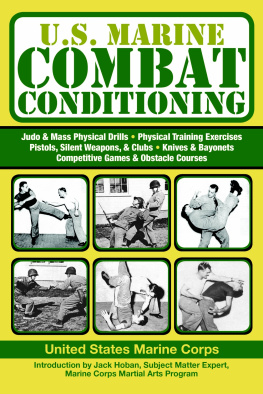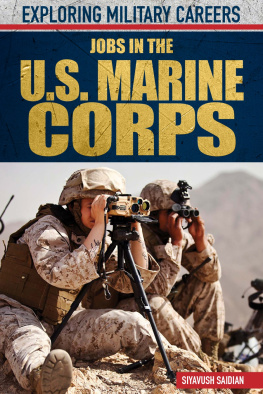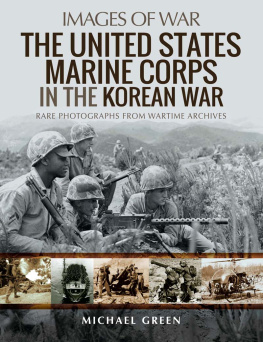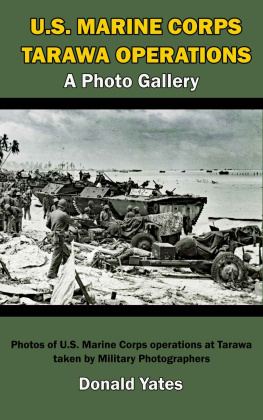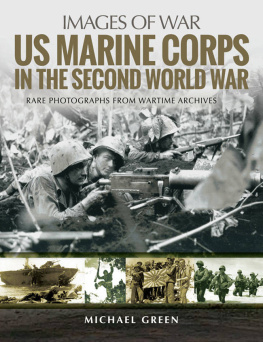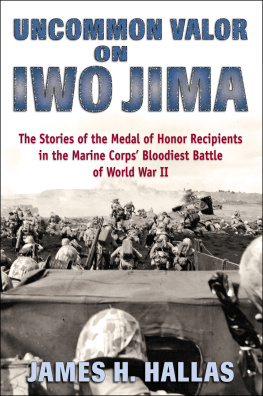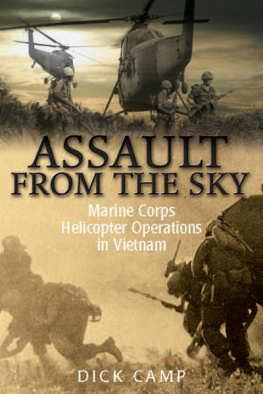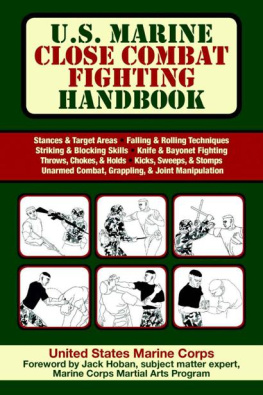United States Marine Corps. - U.S. Marine Combat Conditioning
Here you can read online United States Marine Corps. - U.S. Marine Combat Conditioning full text of the book (entire story) in english for free. Download pdf and epub, get meaning, cover and reviews about this ebook. year: 2011, publisher: Skyhorse, genre: Home and family. Description of the work, (preface) as well as reviews are available. Best literature library LitArk.com created for fans of good reading and offers a wide selection of genres:
Romance novel
Science fiction
Adventure
Detective
Science
History
Home and family
Prose
Art
Politics
Computer
Non-fiction
Religion
Business
Children
Humor
Choose a favorite category and find really read worthwhile books. Enjoy immersion in the world of imagination, feel the emotions of the characters or learn something new for yourself, make an fascinating discovery.
- Book:U.S. Marine Combat Conditioning
- Author:
- Publisher:Skyhorse
- Genre:
- Year:2011
- Rating:3 / 5
- Favourites:Add to favourites
- Your mark:
- 60
- 1
- 2
- 3
- 4
- 5
U.S. Marine Combat Conditioning: summary, description and annotation
We offer to read an annotation, description, summary or preface (depends on what the author of the book "U.S. Marine Combat Conditioning" wrote himself). If you haven't found the necessary information about the book — write in the comments, we will try to find it.
U.S. Marine Combat Conditioning — read online for free the complete book (whole text) full work
Below is the text of the book, divided by pages. System saving the place of the last page read, allows you to conveniently read the book "U.S. Marine Combat Conditioning" online for free, without having to search again every time where you left off. Put a bookmark, and you can go to the page where you finished reading at any time.
Font size:
Interval:
Bookmark:

(An introductory lecture given to the Candidates by the Chief, Combat Conditioning Section).
1. Definition. Combat Conditioning is the physical and mental conditioning of the individual Marine for hand-to-hand combat. It involves toughening him physically by mass physical drill, by hand-to-hand and bayonet fighting, by competitive games, and by frequent runs through specially designed obstacle and assault courses. It develops in him the realization that skill in hand-to-hand combat and bayonet fighting is vital battle equipment. The goal of combat conditioning is not only to develop physical strength, agility, and endurance in every officer and man of the unit undergoing the training, but also to develop in him confidence in himself as a fighting man with the bayonet, the knife, the club, or with no weapons at all.
2. Program, General .a. Combat Conditioning is an essential part of the progressive training of all Marines. The Combat Conditioning program must be progressive in nature. In addition to conditioning the men physically, the program must be designed to help the men, from the very start, overcome inhibitions for physical contact. It must develop in them eagerness to close with the enemy and confidence in each man in his own and in his comrades abilities to fight hand-to-hand: with the enemy.
b. Physical drill or exercises of some form should be scheduled at least six days a week during the entire training period. The exercises combined with hikes and field work will keep the men in good shape, and will improve their muscle tone and endurance. Some of the exercises are body-building, but since the program is designed for the average man, not every man will get the same benefit from them. However, all men will reach a fairly high common plane of strength and endurance.
c. It is essential that the men learn how to handle their bodies and learn good footwork, rolls and falls, as early as possible. As recruits, the men must accustom themselves to physical contact with the deck and with each other. This is usually accomplished by physical exercises and games where the men work against each other, and by elementary Judo and bavonet exercises.
d. A Combat Conditioning program should be progressive both in teaching and in practicing bayonet work, in disarming, and in Judo fundamentals and techniques. Only the most practicable and easily learned techniques should be taught. The aggressive spirit must be inculcated from the beginning and developed throughout. At any stage of a Marines training there are only a limited number of hours available for Combat Conditioning. However, if the fundamentals are taught first and the refinements later, and if both are practiced whenever possible, the limited time should not impair the opportunities of a combat conditioning program.
e. The Combat Conditioning program at Officer Candidates School comprises eighteen hours of scheduled instruction, and three hours of physical drill, hikes, combat conditioning or work over the obstacle courses weekly during each of the twelve weeks of the course. We realize that the time allotted is not enough for us to teach you all the techniques that might well be taught or to allow you sufficient practice. Nor have we enough time devoted to combat conditioning to keep you in excellent physical condition at all times. We, of course, want to keep you in as good physical condition as possible while you are here, but our primary aim is to teach you combat conditioning and close combat techniques, and show you how you can teach others. All the essential techniques can be taught and absorbed in the time available herea total of 54 hours.
f. Most of you Candidates have previously had about twenty hours of bayonet, Judo, and general physical training at recruit camp, and some of you have had more experience elsewhere. Actually the program used at OCS could be applied directly to new recruits if about two or three times as many hours were allotted for it. All extraneous or superfluous material has been excluded from the course. If recruits were to finish the expanded course, they would have acquired good physical condition, agility, and the aggressive spirit and would be able to use the bayonet effectively in combat. For recruit training purposes, of course, there would be no need for emphasis on training systems or methods of instruction.
(Notes for Instructors.)
3. Program, Administration. The Combat Conditioning program in effect at the Officer Candidates School is shown in outline on pages 4-12 as a suggested guide for similar programs. The instruction generally comes in the afternoon in two consecutive fifty-minute periods. The general plan of the course is explanation and demonstration by the officers and noncommissioned officers of the Combat Conditioning Section followed by practice under supervision of the officers and noncommissioned officer instructors of the company undergoing the instruction. The company instructors also conduct the competitive games and exercises and run their Candidates through the bayonet and obstacle course when scheduled. When a public address system is available it has been found expedient to give much of the bayonet instruction and drill to the company as a unit. The company is placed in an extended formation and one instructor conducts the drill from the microphone while the other instructors circulate within their platoons, make any corrections necessary, and assist in any other ways possible. The uniform for all hands is dungarees.
4. Equipment Used .a. The following equipment is used in the various phases of training:
(1) Physical drill. Rifles, Pine Logs, twenty-five feet long and six inches to one foot in diameter. Abdominal Rise (situps) Raila wooden rail, padded with canvas, 100 feet long and 3 feet high.
(2) Judo and deck work .A sawdust pit approximately 80 by 100.
(3) Club. Wooden clubs two feet long and 1 in diameter.
(4) Pistol .Dummy wooden pistols, same size as the Automatic Pistol, Caliber .45, M1911.
(5) Knife .M1 Bayonets, with scabbards affixed.
(6) Bayonet .Surveyed M1903 rifles, M1 bayonets, and surveyed wooden M1903 scabbards cut down to fit the M1 bayonets. (Surveyed rifles are used instead of M1 rifles since no protective front sight covers are available for the M1s and because the M1 bayonet scabbard splinters when used for bayonet practice. We have taken the long, surveyed M1903 wooden scabbards, cut them down, and taped them. Scabbards are fixed for all bayonet work except the running of the various obstacle and bayonet courses.)
(7) Obstacle and bayonet courses. There are four courses, each different from the others. All except the first one of these are run with rifles and bayonets.
(8) Obstacle course. The obstacle course for the individual man involves: weight lifting by rope and pulley; rope climbing; cargo net descent; stepping high and fast over criss-crossed logs; scaling a wall; traversing a horizontal rope hand over hand; stepping in and out of staggered boxes in rows while on the double; running across a straddle run (two 6 x 20 walls forming a V at the bottom and representing the deck of a heaving ship) ; running through vertical hatchways; hurdling two low and two high track hurdles; running across a long sand pit; and duck-waddling a certain distance. This course is run quite frequently by the Candidates. See .
(9) Bayonet course. The course is run on the double by individuals with rifle and bayonet. The details are shown on pages 289-295. This course is run a total of about six times by Candidates on three different days. See Figure 103.
Font size:
Interval:
Bookmark:
Similar books «U.S. Marine Combat Conditioning»
Look at similar books to U.S. Marine Combat Conditioning. We have selected literature similar in name and meaning in the hope of providing readers with more options to find new, interesting, not yet read works.
Discussion, reviews of the book U.S. Marine Combat Conditioning and just readers' own opinions. Leave your comments, write what you think about the work, its meaning or the main characters. Specify what exactly you liked and what you didn't like, and why you think so.

